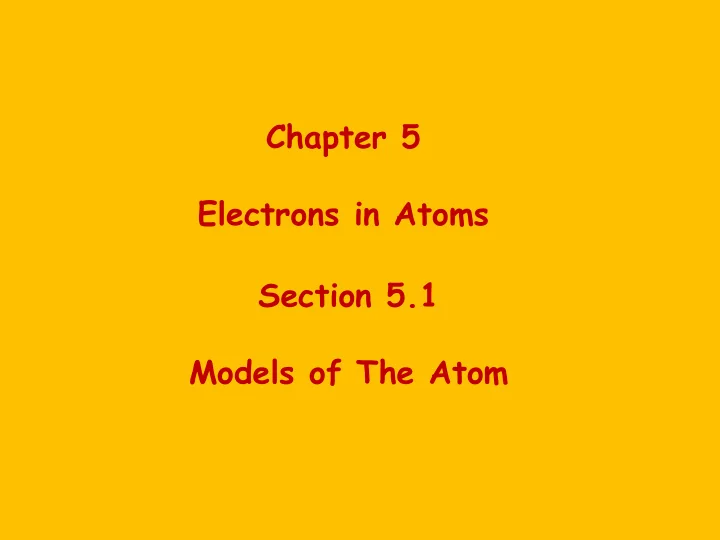

Chapter 5 Electrons in Atoms Section 5.1 Models of The Atom
Rutherford’s atomic model could not explain the chemical properties of elements. It only explains a few simple properties of atoms. Niels Bohr , a Danish Physicist, improved Rutherford’s model. He proposed that an electron is found only in specific circular paths, or orbits, around the nucleus. Bohr Model 1. Each possible electron orbit has a fixed energy called, energy level. 2. An electron can move from one orbit to another if it loses or gains energy. in other words, if an electron gains energy, it will move to the higher orbit and vice versa. Go to page: 129 The required energy to move an electron from one energy level to another is called, Quantum
Erwin Schrodinger , an Austrian Physicist, improved the Bohr’s Model Quantum Mechanical Model It determines that allowed energies an electron can have and how likely it is to find the electron in various locations around the nucleus. He assumed that the probability of finding an electron within a certain volume of space surrounding the nucleus can represented as a fuzzy cloud. Atomic Orbital A region of space in which there is a high probability of finding an electron. The energy levels of electrons in the quantum mechanical model are labeled by principal quantum numbers (n), assigned as n =1, 2, 3, 4 and so forth. Principal energy level consists of energy sublevels, s, p, d, f And each energy sublevel is composed of orbitals, each orbital is composed of maximum two electrons.
Principal Number of Sublevels Type of Sublevel Energy Level n = 1 1 1s (1 orbital) n = 2 2s (1 orbital), 2p (3 orbitals) 2 n = 3 3s (1 orbital), 3p (3 orbitals), 3d (5 orbitals) 3 4s (1 orbital), 4p (3 orbitals), 4d (5 orbitals), n = 4 4 4f (7 orbitals) Maximum Numbers of Electrons Energy Level n Maximum number of electrons 1 2 2 8 3 18 4 32
Section 5.2 Electron Arrangement in Atoms
Electron Configurations The ways in which electrons are arranged in various orbitals around the nuclei of atoms. The e electr tron on confi figura uration tion should uld follow low three ee rules: es: Aufbau Principle Electrons occupy the orbitals of lowest energy first. Which is lower in energy 4s orbital or 3d orbital??? Think !!! Pauli Exclusion Principle An atomic orbital may describe at most two electrons, and at the same orbital two electrons must have opposite spins Hund’s Rule Electrons occupy orbitals of the same energy in a way that makes the number of electrons with the same spin direction as large as possible.
e.g. If you have 3 electrons to fill p orbitals, how can you do it? X \ Go to page: 134, Table 5.3 Write the electron configuration for each following atoms: a. Potassium b. Aluminum c. Copper Some actual electron configurations differ from those assigned using the Aufbau principle because half filled sublevels are not as stable as filled sublevels, but they are more stable than other configurations.
Recommend
More recommend